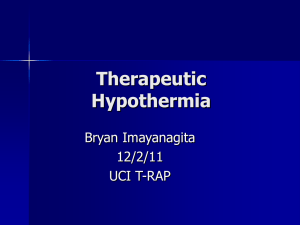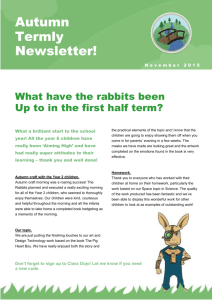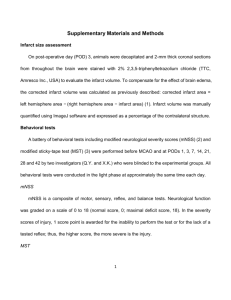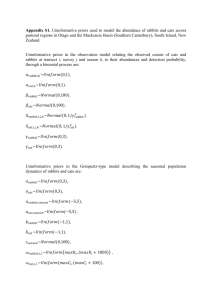Ultrafast cardiac cooling initiated by liquid ventilation abolishes
advertisement
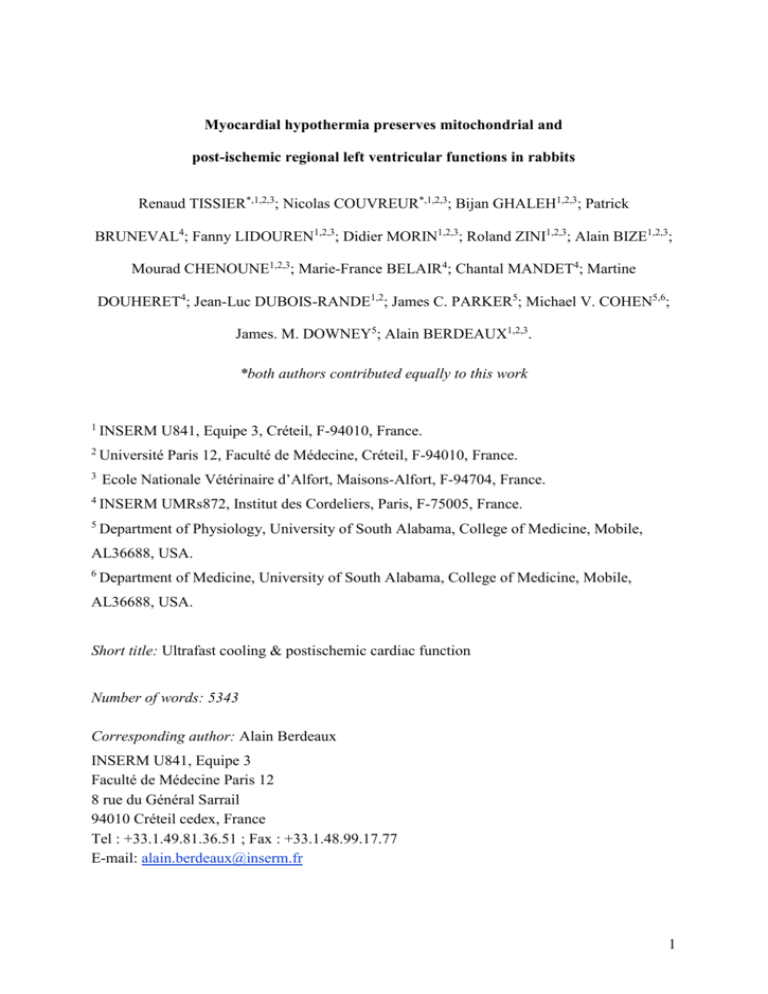
Myocardial hypothermia preserves mitochondrial and post-ischemic regional left ventricular functions in rabbits Renaud TISSIER*,1,2,3; Nicolas COUVREUR*,1,2,3; Bijan GHALEH1,2,3; Patrick BRUNEVAL4; Fanny LIDOUREN1,2,3; Didier MORIN1,2,3; Roland ZINI1,2,3; Alain BIZE1,2,3; Mourad CHENOUNE1,2,3; Marie-France BELAIR4; Chantal MANDET4; Martine DOUHERET4; Jean-Luc DUBOIS-RANDE1,2; James C. PARKER5; Michael V. COHEN5,6; James. M. DOWNEY5; Alain BERDEAUX1,2,3. *both authors contributed equally to this work 1 INSERM U841, Equipe 3, Créteil, F-94010, France. 2 Université Paris 12, Faculté de Médecine, Créteil, F-94010, France. 3 Ecole Nationale Vétérinaire d’Alfort, Maisons-Alfort, F-94704, France. 4 INSERM UMRs872, Institut des Cordeliers, Paris, F-75005, France. 5 Department of Physiology, University of South Alabama, College of Medicine, Mobile, AL36688, USA. 6 Department of Medicine, University of South Alabama, College of Medicine, Mobile, AL36688, USA. Short title: Ultrafast cooling & postischemic cardiac function Number of words: 5343 Corresponding author: Alain Berdeaux INSERM U841, Equipe 3 Faculté de Médecine Paris 12 8 rue du Général Sarrail 94010 Créteil cedex, France Tel : +33.1.49.81.36.51 ; Fax : +33.1.48.99.17.77 E-mail: alain.berdeaux@inserm.fr 1 Abstract : Myocardial hypothermia preserves mitochondrial and post-ischemic regional left ventricular functions in rabbits. R. Tissier; N.Couvreur; B. Ghaleh; P. Bruneval; F. Lidouren; D. Morin; R. Zini; A. Bizé; M. Chenoune; M-F. Bélair; C. Mandet; M. Douheret; J-L. Dubois-Randé; J.C. Parker; M.V. Cohen; J.M. Downey; A. Berdeaux. Aims: We investigated whether cooling instituted by total liquid ventilation (TLV) improves cardiac and mitochondrial functions in rabbits submitted to lethal myocardial ischemia. Methods: Rabbits were instrumented with a coronary artery occluder and myocardial ultrasonic crystals for assessment of segment length shortening. Two weeks later they were reanesthetized and underwent either a normothermic 30-min coronary artery occlusion (CAO) (Control group, n=7) or a comparable CAO with cooling initiated after 5-min of occlusion. Cooling was initiated by a 10-min hypothermic TLV episode and then maintained by icefilled cold blanket put over the skin (Hypo-TLV group, n=6). A last group underwent normothermic TLV during CAO (Normo-TLV group, n=6). Wall motion was measured in the conscious state over 3 days of reperfusion before infarct size evaluation and histology. Additional experiments were done in anesthetized rabbits for myocardial sampling at the end of the ischemic period (electron microscopy and mitochondrial studies). Results: The cooling procedure induced a rapid decrease in heart temperature to a target 3234°C. Post-ischemic contractile dysfunction and infarct sizes were significantly decreased in Hypo-TLV vs Control and Normo-TLV (e.g., 4±1, 39±2 and 42±5% of region at risk for infarct sizes, respectively). Mitochondrial function was improved by Hypo-TLV regarding ADP-stimulated respiration and calcium-induced opening of mitochondrial permeability transition pore (mPTP). Histology and electron microscopy revealed also better preservation of lung and cardiomyocyte ultrastructure in Hypo-TLV as compared to Control, respectively. Conclusion: Institution of hypothermia by TLV during ischemia not only reduces infarct size but also abolishes most consequences of ischemia such as post-ischemic contractile dysfunction and calcium-induced opening of mPTP. 2 KEY WORDS Cooling Contractile function Mitochondria Infarction Total liquid ventilation. Discipline : experimental Object of Study : heart Level : organism Expertise : pathophysiology 3 Introduction Among the numerous experimental strategies that have been proposed to reduce myocardial infarct size, one of the most potent is cooling the heart during ischemia to 32 to 34°C 1-3. At these temperatures the heart beats normally and no external support of the circulation is required. However, the cooling rates that can be achieved by cooling the skin 4 or using intravascular thermodes 1 are too slow to be optimally clinically effective. Although cooling with these techniques may be started during the ischemic period, target temperatures are not reached until well into reperfusion and most experimental reports have noted that hypothermia does not significantly decrease infarct size when applied only during the postischemic reperfusion period 2, 5-7. To exert optimal protection a cooling strategy should aim to lower temperature to the desired target very fast after the onset of coronary artery occlusion to effectively shorten normothermic ischemic time. Total liquid ventilation (TLV) with temperature-controlled perfluorocarbons has been proposed for rapid cooling 6, 8, 9 as these liquids have a high thermal conductivity and can use the lungs as heat exchangers while still maintaining gas exchange 8, 10, 11. In a previous report, we demonstrated in anesthetized rabbits that a left atrial temperature of 32°C could be achieved within 5 min using TLV with cooled perfluorocarbons 6. This was associated with a dramatic decrease in infarct size when hypothermic TLV (Hypo-TLV) was performed during a 30-min coronary artery occlusion. However, it is unknown if animals will recover after Hypo-TLV and whether it would preserve contractile function and lung structure. It is indeed well known that infarct size reduction does not accurately predict contractile recovery, i.e., myocardium could be salvaged but still dysfunctional 12, 13. The exact mechanism by which hypothermia protects the heart against ischemia remains still unknown. Reduction in ATP consumption 14, intracellular acidosis, and Na+ and Ca+ overload 15 would be likely components of a mechanism resulting in a reduction of 4 myocardial energy utilization 16 and inhibition of intracellular processes already associated with cell necrosis. Preserved mitochondrial function has also been proposed to protect isolated hypothermic heart against ischemia 17. However, this last report was performed following ex vivo 17°C deep hypothermia. The effect of moderate 32-34°C hypothermia was much less investigated on ischemia-induced mitochondrial dysfunction despite this organite, and in particular mitochondrial permeability transition pore (mPTP) are key targets of cardioprotection 18-22. It would indeed provide new mechanistic insight to determine whether hypothermia, a cardioprotective maneuver not related to pre- or postconditioning would also protect mitochondria. The goal of the present study was therefore to investigate whether cooling induced by TLV improves cardiac and mitochondrial functions in rabbits submitted to lethal ischemia. Accordingly, we first investigated left ventricular recovery in an infarction model of chronically instrumented rabbits. Second, we did mitochondrial studies from myocardial samples performed in additional rabbits submitted to coronary artery occlusion. Mitochondria structure and function were investigated by electron microscopy, oxygen consumption and calcium-induced opening of mitochondrial permeability transition pore opening evaluations, respectively. In all experiments, hypothermia was induced by a brief period of Hypo-TLV and then maintained by noninvasive surface cooling. 5 Methods The animal instrumentation and the ensuing experiments were conducted in accordance with French official regulations after approval by the local ethical comitee. All experiments were performed in male New Zealand rabbits (2.5-3.0kg). Instrumentation Rabbits were anesthetized with a mixture of tiletamine (25 mg/kg IV) and zolazepam (25 mg/kg IV), intubated, and mechanically ventilated. Maintenance of anesthesia was done with pentobarbital and inhaled 2% isoflurane. A left thoracotomy was performed under sterile conditions and a pneumatic occluder was implanted around a major branch of the left coronary artery 12, 13. A pair of 1-mm ultrasonic piezoelectric crystals was inserted within the left ventricular wall in the perfusion territory of the instrumented coronary artery. The chest was closed in layers. The occluder tubing and the crystal wires were exteriorized between the scapulae. During the postoperative period rabbits received buprenorphine (0.02 mg/kg/12h SC, 3 days) and spiramycine (60,000 IU/kg/day IM, 5 days). Rabbits recovered for a minimum of 10 days after surgery before inclusion in the study. Experimental protocol After recovery from surgery baseline hemodynamic parameters were recorded in the conscious state in all rabbits. They were then reanesthetized using thiopentone (20 mg/kg IV) and intubated for conventional mechanical ventilation. As shown in Figure 2A rabbits were divided into 3 groups. All underwent 30min of coronary artery occlusion (CAO) to induce infarction and 3 days of reperfusion. The first group (Control) was not subjected to any other treatment. The second group (Hypo-TLV) was cooled starting at the 5th min of CAO using the combination of 10 min of hypothermic TLV and 25 min of surface cooling with ice-filled cold blankets. The last group (Normo-TLV) was treated with 10 min of normothermic TLV initiated in the 5th min of CAO. In the cooled Hypo-TLV groups, warm-up was initiated at the 6 onset of reperfusion using infra-red lamps and a heating pad until the return of normothermia as monitored by the rectal temperature probe. Rabbits were allowed to wake up and breathe spontaneously as soon as possible after initiation of reperfusion. They were kept in a cage with supplemental oxygen for 24-48h. In the Hypo-TLV and Normo-groups, TLV episodes were performed using our liquid ventilator as previously described 6. Briefly, we used a mixture of perfluorobutyltetrahydrofurane and perfluoropropyltetrahydropyrane (RM101, Miteni, Milano, Italy). The ventilator was set to a tidal volume of 15 ml/kg body weight and 5 breaths/min. This protocol has previously been demonstrated to maintain normal blood gases 6. The perfluorocarbon mixture was bubbled with 100% O2. The temperature of the heat exchanger was set to either 15 or 39°C in the Hypo-TLV and Normo-TLV groups, respectively. In order to avoid multiple blood samples in rabbits in which hemodynamic was investigated, we performed blood gas analyses (ABL77, Radiometer Medical ApS, Brønshøj, Denmark) in additional rabbits submitted to Control or Hypo-TLV procedures (n=4 in each conditions). Blood gas values were corrected for the actual body temperature. In order to measure myocardial temperature during the TLV procedure, additional rabbits were anesthetized and mechanically ventilated. A left lateral thoracotomy was performed and a thermal probe was implanted within the left ventricular wall for measurement of myocardial temperature. The chest was closed in layers and fifteen minutes later rabbits were randomly divided into the same three groups as described above, but no coronary artery occlusion was performed. Rectal and myocardial temperatures were continuously monitored for 25 min (Figure 1, upper panel). Hemodynamic measurements in chronically instrumented rabbits Data were digitized and analyzed using the data acquisition software HEM 3.5 (Notocord Systems, Croissy sur Seine, France). A catheter was positioned in the artery of the rabbit's ear for arterial blood pressure measurement (Statham P23ID strain gauge; Statham 7 Instruments, Oxnard, CA) during CAO and during the first hour of reperfusion. An external electrocardiogram was also recorded. As previously described 12, 13, regional segment length was measured by connecting the crystal wires to an ultrasound module (Module 201, System 6; Triton Technology, San Diego, CA). Segment systolic shortening was calculated as the difference between end-diastolic and end-systolic lengths normalized for the end-diastolic length. A phonocardiogram was recorded for detection of the beginning and end of systole 12, 13 . Post-mortem analyses and histology After completion of three days of reperfusion, the chronically instrumented rabbits were euthanized using pentobarbital (60 mg/kg IV) followed by potassium chloride. The hearts were excised and the coronary artery was ligated at the occluder site. The ascending aorta was cannulated and perfused retrogradely with Alcyan blue (0.5%). The left ventricle was cut into slices, weighed, and incubated in 1% triphenyltetrazolium chloride (TTC). Slices were fixed in formaldehyde and photographed. Risk and infarcted zones were quantified by planimetry and expressed as percentages of the left ventricle and risk zone, respectively. To determine the extent of myocardial infarction between implanted crystals, we analyzed the formaldehyde-fixed myocardium between the crystals. As previously described a computerized reconstruction of the complete hematoxylin-eosin stained histological section was made by juxtaposition of digital photographs 12. Planimetry was performed and infarction between crystals was quantitated. Lungs were also analyzed by histology using hematoxylineosin staining. Electron microscopy In order to further investigate myocardial integrity following the Hypo-TLV procedure, experiments were performed in 6 additional anesthetized rabbits (3 Hypo-TLV and 3 Controls). After opening the chest, a prominent branch of the left coronary artery was 8 occluded for 30 min. The chest was immediately closed and rabbits were subjected to either no procedure (Control) or to cooling with Hypo-TLV initiated in the 5th min of CAO. Just before completion of the 30 min CAO, the chest was reopened in order to reperfuse the ligated artery. Fifteen seconds after the onset of reperfusion, hearts were removed and perfused-fixed through the aorta with 2.5% glutaraldehyde. A 5x5mm sample of myocardium was excised from both the ischemic and non-ischemic areas. Each sample was cut into 1mm tissue blocks which were embedded in Epon for standard electron microscopy. Five blocks from each area were randomly selected for analysis (total number of blocks = 60). Investigation of mitochondrial oxygen consumption and calcium-induced permeability transition pore opening A cardiac mitochondrial fraction was prepared from additional rabbits acutely subjected to a 30 min CAO with either Control or Hypo-TLV procedures (n=5 in each condition, Figure 4A). Immediately after completion of CAO, hearts were rapidly excised. As previously described 23, two samples from the territories submitted to ischemia and from non ischemic myocardium were rapidly minced in a cold buffer (220 mM mannitol, 70 mM sucrose, 10 mM HEPES, 1 mM EGTA, 0.04 mM free fatty acid bovine serum albumin, pH= 7.4). Homogenates were centrifuged at 1000 g for 5 min and supernatants were centrifuged at 10000 g for 10 min. The final mitochondrial pellets were resuspended in 200 µl of homogenization buffer containing only 0.1 mM EGTA. Oxygen consumption was measured with a Clark type electrode in the respiration buffer (50 mM sucrose, 100 mM KCl, 10 mM HEPES, 5 mM KH2PO4) containing 0.4 mg/ml of mitochondria, as previously described 23. Substrate-respiration rate (state 4 oxygen consumption) and ATP synthesis (state 3) were investigated by addition of 5 mM pyruvate/malat and 300 µM ADP, respectively. The corresponding respiration control ratio (state 3/ state 4) was calculated. In other experiments, the mitochondrial ability to retain Ca2+ was monitored until opening of mitochondrial 9 permeability transition pore (mPTP). Accordingly, mitochondria were loaded with increasing concentrations of Ca2+ until the load reached a threshold where mitochondria underwent a fast process of Ca2+ release due to mPTP opening (Figure 4C). Cardiac mitochondria (1 mg/ml) energized with 5 mM pyruvate/malate were incubated in the respiration buffer including 1 µM of the Ca2+ green-N fluorescent probe. The reaction was started by addition of successive 10 µM Ca2+ pulses. When maximal Ca2+ loading threshold was reached, this equilibrium was disrupted and Ca2+ was released. Our investigational index was this ultimate Ca2+ concentration triggering mPTP opening. The concentration of Ca2+ in the extramitochondrial medium was monitored by means of a Perkin-Elmer® LS 50B spectrofluorimeter at excitation and emission wavelength of 506 and 532 nm, respectively. The Ca2+ signal was calibrated by addition to the medium of known Ca2+ amounts. Statistical analysis Values are expressed as means ± SEM. Comparisons were compared using either a one- or two-way ANOVA followed by a Student's t-test with Bonferroni correction. Mortality and incidence of ventricular fibrillation between groups were compared using χ2 test. Significant differences were determined when p < 0.05. 10 Results Changes in myocardial and core temperatures during the cooling process As shown in Figure 1 (lower panel) myocardial and rectal temperatures were significantly decreased in Hypo-TLV as compared to Control and Normo-TLV (p<0.05). For example, myocardial temperature decreased by an average of 4.3±0.2 °C at the 15th min of the cooling procedure. Blood gases during the cooling process During conventional mechanical ventilation, blood gases were within normal range in Control conditions (e.g., pH=7.4±0.1, pCO2=41±4 mmHg and pO2=531±30 mmHg after 30 min of follow-up). At the end of the Hypo-TLV cooling procedure, blood gases values were also not altered (pH=7.4±0.1, pCO2=32±3 mmHg and pO2=597±14 mmHg), as well as 1 h after (pH=7.4±0.1, pCO2=33±3 mmHg and pO2=538±59 mmHg). Number of rabbits and incidence of arrhythmias in chronic experiments Twenty-five rabbits were initially included in the chronic study. Ten rabbits experienced ventricular fibrillation during the ischemic episode or during early reperfusion: 4 out of 9, 1 out of 7 and 5 out of 9 in Control, Hypo-TLV and Normo-TLV groups, respectively. Finally 7, 6 and 6 rabbits successfully underwent the complete protocol in the Control, Hypo-TLV and Normo-TLV groups, respectively. Hemodynamic parameters and rectal temperature in chronic experiments As shown in Table I, heart rate, mean arterial pressure and rectal temperature were not significantly different among groups at baseline. During CAO heart rate was significantly reduced in Hypo-TLV as compared to Control. Throughout reperfusion, heart rate was not significantly altered among groups. Mean arterial pressures were not different among groups throughout the occlusion-reperfusion protocol. Rectal temperature was significantly reduced in the Hypo-TLV group as compared to other groups. 11 End-diastolic segment lengths were not different among groups throughout the experimental protocol (Table I). Segment length shortening was not significantly different between groups at baseline and during CAO. Segment shortening in Control and Normo-TLV groups remained dramatically depressed throughout the 72-h period of monitoring. In contrast, segment shortening was significantly increased in Hypo-TLV as compared to Control. As shown in Figure 2B, this parameter recovered 95% of its corresponding baseline value after 72 h of reperfusion. Risk zone and infarct sizes in chronic experiments Sizes of risk regions were not significantly different among groups averaging 32±3%, 35±4% and 36±4% of the left ventricle in Control, Hypo-TLV and Normo-TLV groups, respectively. As shown in Figure 2C, infarct size was significantly reduced in Hypo-TLV as compared to Control and Normo-TLV (4±1%, 39±2% and 42±5% of region at risk, respectively). Histology in chronic experiments The overall histological pattern of the myocardial sections between crystals was similar among the three groups of chronically instrumented rabbits. Infarcts consisted of a core of myocyte coagulation necrosis with some residual hemorrhage and edema. Infarcts were surrounded by borders of tissue granulation and inflammation. Infarction between crystals was significantly reduced in the Hypo-TLV group (1±1%) as compared to Control (45±9%) and Normo-TLV (36±6%). In all lungs from the Control group we observed foci of minor to severe congestion (Figure 2D, panel a). In the Hypo-TLV, three rabbits demonstrated normal lungs (Figure 2D, panel b) and three others had only minor congestion. 12 Electron microscopy In all samples from Control and Hypo-TLV rabbits, cellular and extracellular architecture of normally perfused myocardium was intact with normal mitochondria, absence of intracellular edema (Figure 3A) and normal microvessels (Figure 3B). In all samples of ischemic myocardium from Control hearts we observed marked intracellular edema (Figure 3C) with wide-spread irreversible ischemic damage to the mitochondria characterized by amorphous densities and membrane rupture (Figure 3E). In the Hypo-TLV group, intracellular edema was more modest (Figure 3D) and mitochondrial damage was reversible and characterized by minor loss of mitochondrial cristae (Figure 3F). Finally, we observed endothelial cell necrosis in Control samples (Figure 3G) but not in Hypo-TLV hearts (Figure 3H). In vitro mitochondrial oxygen consumption and calcium-induced permeability transition pore opening In Control normothermic hearts, mitochondrial dysfunction in the ischemic territory was demonstrated by a -41% decrease in ATP synthesis (state 3 oxygen consumption) as compared to the non ischemic zone (447±30 vs 763±63 nmoles O2/min/mg Pt, respectively, p<0.05). In Hypo-TLV hearts, state 3 oxygen consumption was decreased by only 25% in ischemic vs non ischemic zones (631±53 vs 841±50 nmoles O2/min/mg Pt, respectively, p<0.05). This parameter was also significantly improved by Hypo-TLV vs Control in the ischemic territory (p<0.05). Conversely, respiration rate (state 4 oxygen consumption) was not altered in the ischemic vs non ischemic zones in both groups (178±21 vs 170±22 nmoles O2/min/mg Pt in the Control group; 158 ±7 vs 166±8 nmoles O2/min/mg Pt in the Hypo-TLV group). As illustrated in Figure 4B, the respiratory control ratio (state 3/ state 4) was significantly decreased by 42% in the ischemic vs non ischemic zones in the Control group. In contrast, respiratory control ratio was significantly less decreased in Hypo-TLV (-21%). 13 As shown in Figure 4D, Ca2+ concentration required to open mPTP was significantly reduced by 49% in the ischemic vs non ischemic zones in the Control group (170±10 vs 86±12 µM, respectively). In contrast, hypothermia protected against mPTP opening as Ca2+ concentration required to open mPTP was not significantly different in the ischemic vs non ischemic zones in the Hypo-TLV group (188±14 vs 157±12 µM). 14 Discussion In the present study we demonstrate that institution of hypothermia during ischemia not only reduces infarct size, as previously reported 2, 3, 7, 24, 25, but also abolishes most consequences of ischemia such as post-ischemic contractile dysfunction and calcium-induced opening of mPTP at the end of the ischemic period. To our knowledge this is the first study to investigate the functional recovery following myocardial infarction and cooling in a 3-day recovery model and to properly compare mitochondrial function following normothermic vs hypothermic ischemia (32-34°C) in in situ beating hearts. To induce ultra-fast hypothermia, we used an original approach instituted by a brief episode of Hypo-TLV. Our results indeed document that a short period of hypothermic TLV can be used to induce ultra-fast cooling that could be maintained by less invasive surface cooling. Importantly, the infarct size reduction elicited by Hypo-TLV was not a chemical effect of the perfluorocarbon mixture since infarct size was not altered with normothermic TLV. This result was expected as the cardioprotective effect of cooling during ischemia has already been demonstrated in rabbits 2, 3, dogs 24, pigs 7 and rats 25. The protection is dependent on the depth of cooling and maximal protection is reached at 32°C 3. Here, we further demonstrate excellent preservation of cardiomyocytes and blood vessel ultrastructure in rabbits subjected to Hypo-TLV compared to Control. This effect was observed in hearts fixed immediately after the onset of reperfusion, again suggesting that the beneficial effect of cooling occurs during ischemia. Similarly, mitochondrial dysfunction in the ischemic territory was inhibited in hypothermic hearts at the end of the ischemic period regarding both oxygen consumption and calcium-induced opening of mPTP. From a mechanistic point of view, this result emphasizes a difference between hypothermia and preconditioning cardioprotective strategies which exert their beneficial effects through activation of protective pathways during reperfusion 18, 26. For example, preconditioning inhibited calcium-induced opening of mPTP 15 during reperfusion in several experimental conditions 27, 28, but not at the end of the ischemic period 19. We should however emphasize that this last report used a low-flow ischemia model that would be different to models of no-flow ischemia. The exact mechanism by which hypothermia inhibits calcium-induced opening of mPTP was not investigated in the present report. However, it was previously reported in isolated guinea pig hearts that a 17°C hypothermia abolished mitochondrial calcium overload during ischemia 17. Conversely, hypothermia did not abolish reactive oxygen species production and even increased baseline levels before ischemia 17. In isolated rat hearts, brief periods of 26°C hypothermia prior to a 37°C ischemia also triggered a preconditioning state through reactive oxygen species production 29. These findings support that hypothermia would at least in part protect the ischemic heart against mPTP opening through inhibition of calcium overload rather than inhibition of reactive oxygen production. Interestingly, this inhibition would be additive to that of cardioprotective strategies acting at reperfusion since postconditioning 30 or low-flow reperfusion 31 inhibited mPTP opening in isolated rat hearts submitted to 8 h of cardioplegia (ischemia at 4°C). Importantly, we observed in the present report rapid and potent recovery of postischemic regional contractility with cooling as compared to normothermic intervention. The recovery was evident as early as 30 min after the onset of reperfusion and virtually complete after 3 days of reperfusion. Early improvement in postischemic contractility was also previously documented with regional topical hypothermia in pigs following 40 min of ischemia and 3 h of reperfusion 32. Conversely, ischemic preconditioning that can induce an ultimate infarct size reduction as potent as that observed with Hypo-TLV failed to improve regional contractility during the first hours of reperfusion in rabbits 12, 13. Preconditioning also did not prevent stunning in dogs submitted to a 15-min ischemic insult 33. These data suggest that cooling during ischemia exerts a powerful protective effect against early post-ischemic 16 dysfunction in addition to its infarct-sparing effect. It has also been reported that a modest decrease in myocardial temperature exerts a positive inotropic and oxygen-saving effect in in situ dog hearts at 34°C 34. The proposed mechanisms include an increased Ca2+ sensitivity of myofilament proteins 35 and improved Ca2+-activated force generation 36. One of our important conclusions is also that brief TLV appeared to be safe. We and others have already demonstrated that hemodynamics and gas exchange are not altered during TLV in rabbits 6, lambs 9, or cats 8. However, our preliminary experiments demonstrated an increased mortality in rabbits subjected to prolonged periods of Hypo-TLV. The cause of these deaths was not pinpointed but that problem was not seen in rabbits exposed to shorter periods of Hypo-TLV as we did in the present report. To our knowledge, this is the first study to demonstrate that short TLV is compatible with rapid resumption of spontaneous breathing without major hypoxia and with minimal lung trauma. Indeed, our rabbits resumed spontaneous breathing only a few hours after the end of the TLV episode. They breathed normally and were maintained in a closed cage breathing air supplemented with oxygen during the initial 24-48h of their recovery. This was to prevent any possibility of hypoxia since atelectasis may occur following TLV 6, 37. Later, rabbits were kept in conventional cages and still breathed normally without hypoxia. Lung histology also demonstrated that HypoTLV did not exert a deleterious effect. We even observed protection against pulmonary edema and congestion in the Hypo-TLV group, further demonstrating the potency of the protection against cardiac mechanical dysfunction. In conclusion, ultra-fast cooling instituted by a brief episode of hypothermic total liquid ventilation in rabbits abolished most consequences of ischemia and resulted in potent infarct size reduction, early and complete contractile recovery, protection against myocardial cellular lesions and prevention of mitochondrial function. 17 Funding This study was supported by grants HL 20648 from the Heart, Lung and Blood Institute of the National Institutes of Health, “TLVenCool 06-JCJC-0078” from the French “Agence Nationale pour la Recherche” and ET7-460 from the Fondation de l’Avenir. Conflict of interest: none declared. 18 References 1. Dixon SR, Whitbourn RJ, Dae MW, Grube E, Sherman W, Schaer GL, Jenkins JS, Baim DS, Gibbons RJ, Kuntz RE, Popma JJ, Nguyen TT, O'Neill WW. Induction of mild systemic hypothermia with endovascular cooling during primary percutaneous coronary intervention for acute myocardial infarction. J Am Coll Cardiol 2002;40:1928-1934. 2. Hale SL, Dave RH, Kloner RA. Regional hypothermia reduces myocardial necrosis even when instituted after the onset of ischemia. Basic Res Cardiol 1997;92:351-357. 3. Miki T, Liu GS, Cohen MV, Downey JM. Mild hypothermia reduces infarct size in the beating rabbit heart: a practical intervention for acute myocardial infarction? Basic Res Cardiol 1998;93:372-383. 4. Ly HQ, Denault A, Dupuis J, Vadeboncoeur A, Harel F, Arsenault A, Gibson CM, Bonan R. A pilot study: the Noninvasive Surface Cooling Thermoregulatory System for Mild Hypothermia Induction in Acute Myocardial Infarction (the NICAMI Study). Am Heart J 2005;150:933.e939-933.e913. 5. Otake H, Shite J, Paredes OL, Shinke T, Yoshikawa R, Tanino Y, Watanabe S, Ozawa T, Matsumoto D, Ogasawara D, Yokoyama M. Catheter-based transcoronary myocardial hypothermia attenuates arrhythmia and myocardial necrosis in pigs with acute myocardial infarction. J Am Coll Cardiol 2007;49:250-260. 6. Tissier R, Hamanaka K, Kuno A, Parker JC, Cohen MV, Downey JM. Total liquid ventilation provides ultra-fast cardioprotective cooling. J Am Coll Cardiol 2007;49:601-605. 7. Maeng M, Mortensen UM, Kristensen J, Kristiansen SB, Andersen HR. Hypothermia during reperfusion does not reduce myocardial infarct size in pigs. Basic Res Cardiol 2006;101:61-68. 8. Shaffer TH, Forman DL, Wolfson MR. Physiological effects of ventilation with liquid fluorocarbon at controlled temperatures. Undersea Biomed Res 1984;11:287-298. 19 9. Forman DL, Bhutani VK, Tran N, Shaffer TH. A new approach to induced hypothermia. J Surg Res 1986;40:36-42. 10. Yang SS, Jeng MJ, McShane R, Chen CY, Wolfson MR, Shaffer TH. Cold perfluorochemical-induced hypothermia protects lung integrity in normal rabbits. Biol Neonate 2005;87:60-65. 11. Hong S-B, Koh Y, Shim T-S, Lee SD, Kim WS, Kim DS, Kim WD, Lim C-M. Physiologic characteristics of cold perfluorocarbon-induced hypothermia during partial liquid ventilation in normal rabbits. Anesth Analg 2002;94:157-162. 12. Aouam K, Tissier R, Bruneval P, Mandet C, Berdeaux A, Ghaleh B. Preconditioning of salvaged myocardium in conscious rabbits with postinfarction dysfunction. Am J Physiol 2005;288:H2763-2769. 13. Cohen MV, Yang X-M, Downey JM. Smaller infarct after preconditioning does not predict extent of early functional improvement of reperfused heart. Am J Physiol 1999;277:H1754-1761. 14. Simkhovich BZ, Hale SL, Kloner RA. Metabolic mechanism by which mild regional hypothermia preserves ischemic tissue. J Cardiovasc Pharmacol Ther 2004;9:83-90. 15. Anderson SE, Liu H, Beyschau A, Cala PM. Effects of cold cardioplegia on pH, Na, and Ca in newborn rabbit hearts. Am J Physiol 2006;290:H1090-1097. 16. Ning X-H, Chi EY, Buroker NE, Chen S-H, Xu C-S, Tien Y-T, Hyyti OM, Ge M, Portman MA. Moderate hypothermia (30 degrees C) maintains myocardial integrity and modifies response of cell survival proteins after reperfusion. Am J Physiol 2007;293:H21192128. 17. Riess ML, Camara AK, Kevin LG, An J, Stowe DF. Reduced reactive O2 species formation and preserved mitochondrial NADH and [Ca2+] levels during short-term 17 degrees C ischemia in intact hearts. Cardiovasc Res 2004;61:580-590. 20 18. Hausenloy DJYellon DM. The mitochondrial permeability transition pore: its fundamental role in mediating cell death during ischaemia and reperfusion. J Mol Cell Cardiol 2003;35:339-341. 19. Boengler K, Gres P, Dodoni G, Konietzka I, Di Lisa F, Heusch G, Schulz R. Mitochondrial respiration and membrane potential after low-flow ischemia are not affected by ischemic preconditioning. J Mol Cell Cardiol 2007;43:610-615. 20. Ruiz-Meana M, Garcia-Dorado D, Miro-Casas E, Abellan A, Soler-Soler J. Mitochondrial Ca2+ uptake during simulated ischemia does not affect permeability transition pore opening upon simulated reperfusion. Cardiovasc Res 2006;71:715-724. 21. Murphy ESteenbergen C. Preconditioning: the mitochondrial connection. Annu Rev Physiol 2007;69:51-67. 22. Boengler K, Gres P, Cabestrero A, Ruiz-Meana M, Garcia-Dorado D, Heusch G, Schulz R. Prevention of the ischemia-induced decrease in mitochondrial Tom20 content by ischemic preconditioning. J Mol Cell Cardiol 2006;41:426-430. 23. Obame FN, Plin-Mercier C, Assaly R, Zini R, Dubois-Rande JL, Berdeaux A, Morin D. Cardioprotective effect of morphine and a blocker of glycogen synthase kinase 3beta, SB216763 [3-(2,4-dichlorophenyl)-4(1-methyl-1H-indol-3-yl)-1H-pyrrole-2,5-dione], via inhibition of the mitochondrial permeability transition pore. J Pharmacol Exp Ther 2008;326:252-258. 24. Schwartz LM, Verbinski SG, Vander Heide RS, Reimer KA. Epicardial temperature is a major predictor of myocardial infarct size in dogs. J Mol Cell Cardiol 1997;29:1577-1583. 25. van den Doel MA, Gho BCG, Duval SY, Schoemaker RG, Duncker DJ, Verdouw PD. Hypothermia extends the cardioprotection by ischaemic preconditioning to coronary artery occlusions of longer duration. Cardiovasc Res 1998;37:76-81. 21 26. Hausenloy DJ, Tsang A, Mocanu MM, Yellon DM. Ischemic preconditioning protects by activating prosurvival kinases at reperfusion. Am J Physiol 2005;288:H971-976. 27. Javadov SA, Clarke S, Das M, Griffiths EJ, Lim KHH, Halestrap AP. Ischaemic preconditioning inhibits opening of mitochondrial permeability transition pores in the reperfused rat heart. J Physiol 2003;549:513-524. 28. Argaud L, Gateau-Roesch O, Raisky O, Loufouat J, Robert D, Ovize M. Postconditioning inhibits mitochondrial permeability transition. Circulation 2005;111:194-197. 29. Khaliulin I, Clarke SJ, Lin H, Parker J, Suleiman MS, Halestrap AP. Temperature preconditioning of isolated rat hearts--a potent cardioprotective mechanism involving a reduction in oxidative stress and inhibition of the mitochondrial permeability transition pore. J Physiol 2007;581:1147-1161. 30. Ferrera R, Bopassa JC, Angoulvant D, Ovize M. Post-conditioning protects from cardioplegia and cold ischemia via inhibition of mitochondrial permeability transition pore. J Heart Lung Transplant 2007;26:604-609. 31. Bopassa JC, Vandroux D, Ovize M, Ferrera R. Controlled reperfusion after hypothermic heart preservation inhibits mitochondrial permeability transition-pore opening and enhances functional recovery. Am J Physiol Heart Circ Physiol 2006;291:H2265-2271. 32. Schwartz DS, Bremner RM, Baker CJ, Uppal KM, Barr ML, Cohen RG, Starnes VA. Regional topical hypothermia of the beating heart: preservation of function and tissue. Ann Thorac Surg 2001;72:804-809. 33. Ovize M, Przyklenk K, Hale SL, Kloner RA. Preconditioning does not attenuate myocardial stunning. Circulation 1992;85:2247-2254. 34. Nishimura Y, Naito Y, Nishioka T, Okamura Y. The effects of cardiac cooling under surface-induced hypothermia on the cardiac function in the in situ heart. Interact Cardiovasc Thorac Surg 2005;4:101-105. 22 35. Stowe DF, Fujita S, An J, Paulsen RA, Varadarajan SG, Smart SC. Modulation of myocardial function and [Ca2+] sensitivity by moderate hypothermia in guinea pig isolated hearts. Am J Physiol 1999;277:H2321-2332. 36. Kusuoka H, Ikoma Y, Futaki S, Suga H, Kitabatake A, Kamada T, Inoue M. Positive inotropism in hypothermia partially depends on an increase in maximal Ca2+-activated force. Am J Physiol 1991;261:H1005-1010. 37. Salman NH, Fuhrman BP, Steinhorn DM, Papo MC, Hernan LJ, Leach CL, Fischer JE. Prolonged studies of perfluorocarbon associated gas exchange and of the resumption of conventional mechanical ventilation. Crit Care Med 1995;23:919-924. 23 Figure legends Figure 1 Myocardial and rectal temperatures in anesthetized rabbits submitted to hypothermic or normothermic liquid ventilation. Hypo-TLV: hypothermic total liquid ventilation; Normo-TLV: normothermic total liquid ventilation; *, p<0.05 vs Control and Normo-TLV throughout follow-up. Figure 2 Cardioprotective effect of cooling induced by hypothermic liquid ventilation in chronically instrumented rabbits. A: Experimental protocol. B: Change in segment length shortening throughout the experimental protocol (expressed as % change from baseline). C: Infarct sizes expressed (as % of the risk zone). D: Lung histology showing severe congestion (arrowhead) in the Control group (a, Bar=60µm) and normal appearance in the Hypo-TLV group (b, Bar=60µm). See legend of Figure 1; CAO: coronary artery occlusion; CAR: coronary artery reperfusion; SL: segment length shortening*, p<0.05 vs Control and Normo-TLV throughout reperfusion. 24 Figure 3 Electron microscopic analysis of the myocardium A and B: Normal ultrastructure of myocardium in the non-ischemic area in both Control (A, X12,500) and Hypo-TLV (B, X8,000) groups. C and D: More marked intracellular edema in the ischemic area in the Control (C, X6,300) than in the Hypo-TLV group (D, X6,300). E and F: Wide-spread irreversible ischemic damage to the mitochondria in the ischemic area of the Control group with amorphous densities (arrows) and membrane rupture (arrowhead) (E, X12500). In the Hypo-TLV group (F, X12500), the mitochondrial damage is reversible and characterized by minor loss of mitochondrial cristae (arrows). G and H: Damage of the microvessels (V) showing endothelial cell necrosis in the ischemic area in the Control group (G, X12500). In the Hypo-TLV group (H, X12500), the microvessels (V) are normal. See legend of Figure 1. Figure 4 Mitochondrial in vitro oxygen consumption and calcium-induced opening of permeability transition pore. A: Experimental protocol before myocardium sampling within ischemic and non ischemic territories in Control and Hypo-TLV groups. B: Respiratory control ratio (state 3 / state 4 oxygen consumptions) in ischemic vs non ischemic zones. C: Typical recording of an experiment of Ca2+-induced mitochondrial permeability transition pore (mPTP) opening in mitochondria extracted from a non ischemic zone of a Control heart. 25 Experiments consisted in the addition of successive 10 µM Ca2+ pulses with a follow-up of Ca2+ levels (Ca2+ green-5N fluorescence expressed in arbitrary units, AU). D: Mitochondrial ability to retain Ca2+, expressed as mean calcium concentration inducing opening of mitochondrial permeability transition pore (mPTP) in ischemic and non ischemic territories. See legend of Figure 1. *, p<0.05 vs corresponding non ischemic zone; †, p<0.05 vs corresponding Control value. 26 Table I Hemodynamic parameters and rectal temperature. Baseline CAO Reperfusion 15min 25min 1h 2h 3h 24h 48h 72h 234±11 243±11 234±9 248±16 177±13* 241±15 242±15 200±7* 238±16 234±13 243±9 230±17 239±10 248±11 250±12 246±9 244±15 257±10 242±14 251±8 243±13 242±12 240±13 241±18 243±13 244±15 243±13 84±2 84±4 84±3 68±8 73±6 74±2 68±8 66±4 67±5 73±8 69±5 68±6 7.5±1.0 6.8±1.1 7.1±1.1 7.7±1.1 7.5±1.2 7.2±0.9 7.7±1.2 7.4±1.1 7.3±1.0 7.8±1.1 6.9±1.0 7.1±1.0 7.9±1.1 6.8±1.0 7.2±1.0 7.8±1.1 6.8±1.1 7.2±1.0 7.9±1.1 6.7±1.1 7.4±1.0 7.8±1.1 6.8±1.1 7.2±1.0 8.0±1.1 6.7±1.1 7.0±1.0 15.2±2.3 15.8±2.7 14.9±3.1 -2.1±0.3 -0.9±0.4 -2.1±0.5 -1.4±0.4 -1.3±0.3 -1.7±0.5 0.9±0.6 8.3±1.8* 0.9±1.1 0.9±0.7 8.8±1.7* 0.7±1.1 0.4±0.8 0.4±1.0 0.6±0.8 1.8±0.6 11.1±2.2* 12.5±2.0* 15.3±4.0* 15.1±3.3* 0.3±0.8 1.0±1.4 1.1±1.0 1.1±0.8 39.1±0.3 39.2±0.1 39.3±0.2 38.8±0.3 36.3±0.5* 38.9±0.2 38.6±0.3 34.8±0.6* 38.7±0.2 39.0±0.4 36.2±0.6* 38.3±0.3 38.9±0.8 38.1±0.3 38.5±0.2 39.0±0.9 38.7±0.3 38.8±0.2 Heart rate (beats/ min) Control TLVH TLVN Mean arterial blood pressure (mmHg) Control TLVH TLVN Segment length at the end of diastole (mm) Control TLVH TLVN Segment length systolic shortening (%) Control TLVH TLVN Rectal temperature (°C) Control TLVH TLVN CAO, coronary artery occlusion; TLVH: hypothermic total liquid ventilation; TLV N: normothermic total liquid ventilation; * p<0.05 vs Control and TLVN 27 Figure 1 28 Figure 2 29 Figure 3 30 Figure 4 31

